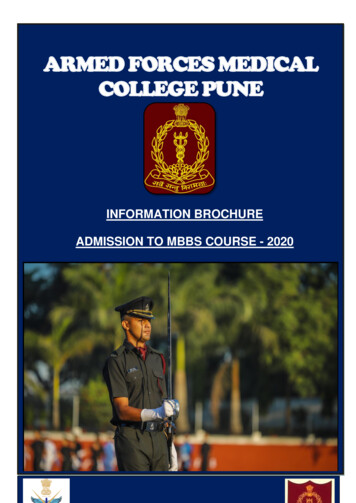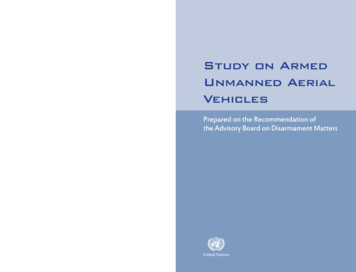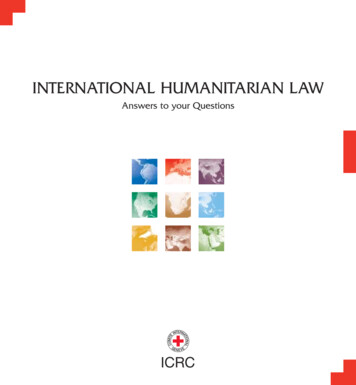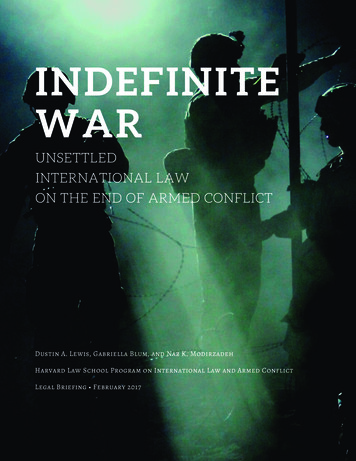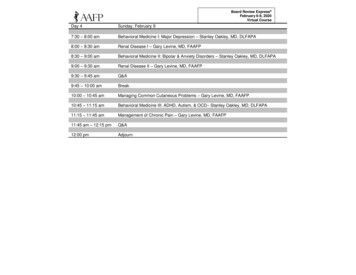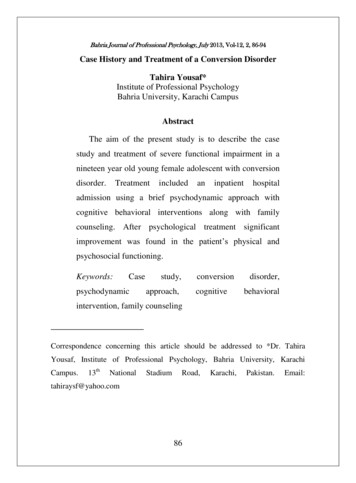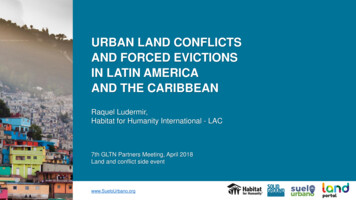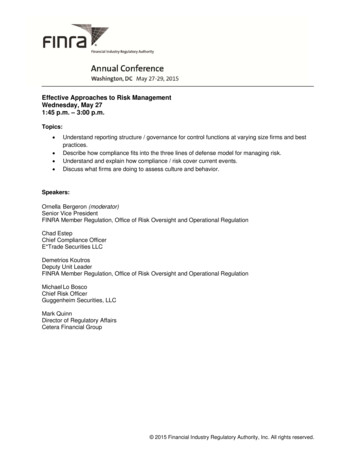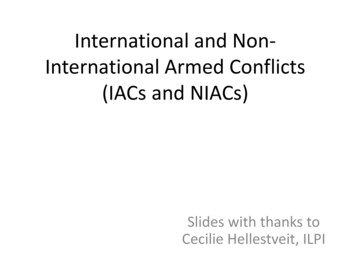
Transcription
International and NonInternational Armed Conflicts(IACs and NIACs)Slides with thanks toCecilie Hellestveit, ILPI
Overview of Lecture IAC – NIAC Major differences Combatants and civilians in IAC :– Immunity from prosecution for lawful acts of war– Immunity from direct targeting in IAC– Regime of protection in detention Combatants and civilians in NIAC :– Immunity from prosecution for lawful acts of war– Immunity from direct targeting in NIAC Treaty law in NIAC: CoH, Prosecution, Detention Summary
Categories of Armed Conflicts in IHL IACs ( internationalarmed conflicts) 5-10% of all ”massiveorganized violence” 19902008 Entire body of IHL treaty lawand IHL customary lawapplicable ” declared war or anyother armed conflict whichmay arise between two ormore of the HighContractingParties” GCCommon art. 2 NIACs ( noninternational armedconflicts) 90-95 % of all "massiveorganized violence" 19902008 only a limited part ofIHL treaty law and IHLcustomary law applicable ”.armed conflict not ofan international characteroccurring in the territoryof one of the HighContracting Parties” GCCommon art. 3 (lowestthreshold).
IAC versus NIACIAC :1) State parties at ’both sides’1) State party on one side, thenon-state party consistingof (peoples) ” fightingagainst colonial dominationand alien occupation andagainst racist regimes”API art 1(4)3) State party on one side,non-state party’s actions”attributable” to anotherStateNIAC1) State party(ies) at only oneside2) No State party at any side
GC I-IVAPIDISTINCTIONIACAPI art 1(4)IACAPII GC CA 3sNIACNIAC IACdue to ‘cause’PARTIESSTATES ON BOTHSIDESGC art 2 :« between two ormore HighContracting Parties »STATE VERSUSSTATE-ASPIRINGACTORAPI art 1(4)« peoples » « in right ofself-determination »Q: is there a State –actor on both sides ?No de jure applicationSTATE OR NONSTATE ACTORVERSUS NONSTATE ACTOR
GC I-IVAPIDISTINCTIONIACAPII GC CA 3sInternationalizedNIACNIACState aids insurgensIF : acts of insurgentsATTRIBUTABLE toStatePARTIESSTATES ON BOTHSIDESGC art 2 :« between two ormore HighContracting Parties »STATE versusSTATE-ASPIRINGPEOPLE API 1(4)ICJ: ”effective control”ICTY: ”overall control” IAC between thetwo States involvedSTATE OR NONSTATE ACTORVERSUS NONSTATE ACTOR
Applicability of IHL Ratione materiae – the notion of armed conflict(IACs and NIACs); Ratione personae – addresses of IHL, rights andduties of the parties to an armed conflict; Ratione loci – geographical/spatial scope ofapplication; Ratione temporis – start and end of hostilities.
Israel – Hezbollah 2006 On 12 July 2006, Hezbollah – a non-State actor with territorial control inSouthern Lebanon, fired rockets at Israeli border towns, and attacked aborder control on the Israeli side of the fence. Result among Israeli soldiers:2 wounded, 3 killed, 2 captured and taken to Lebanon. Israeli army followedHezbollah into Lebanon, another 5 Israeli soldiers killed in planned ambush. Israel responded by airstrikes into Lebanon, and asked the Lebanese state tointervene. After a few days, the Lebanese leadership responded that ”theywould not intervene in the face of such blatant aggression and destructionas the one Israel was showing into Lebanese territory”, and that they were”fully supportive of the defensive actions of Hezbollah”.
Colombia and FARC On March 1, 2008, the Colombian army attacked a base of theFARC – a Colombian non-state organization with some territorialcontrol in parts of Colombia, killing over 20 ( 16 insurgents and 5civilians). The base was located in Ecuador. A country with agovernment which is ’friendly’ towards the FARC. The Colombianauthorities did not contact Ecuador prior to the attack. Ecuador and Venezuela condemned the attack, cut theirdiplomatic relations with Colombia, and started to prepare theirarmies, lining them up along the Colombian border.
Iraq 2003-2004 On 20 March 2003, an international coalition attacked Iraq , withthe aim of removing the regime of Saddam Hussein. Thecampaign lasted until May 1, when the coalition forces hadcontrol and eventually established an occupation regime. During the invasion, local resistance movements (Iraqi insurgents,Peshmergas etc) were fighting alongside coalitions forces. On 28 June 2004, the CPA, the occupation-authorities of Iraq,handed the sovereign authority of Iraq over to an Iraqitransitional council, preparing for elections. The foreign militaryforces would still do the main fighting against insurgents andremnants of the Iraqi army of the former regime.
Georgia and South –Ossetia On 8 August 2008 the Georgian army went into South-Ossetia, aGeorgian region, to quell insurgents aiming to secede SouthOssetia from Georgia. 4 Russian peace-keepers were killed. 9 August 2008: the Russian army went over the border to South– Ossetia in order to ’ protect South-Ossetians and Russiannationals from Georgian aggression’. During the war, South- Ossetian irregular forces were fightingagainst the Georgian forces.
IAC NIAC– Iraq– Afghanistan NIAC IAC– Lebanon– Georgia– (Colombia) Often more than oneconflict at a time.Individually assessed.– Iraq, Georgia Objective assessment–––Reason for conflict not relevantThe opinion of parties not decisive( underlying reality)Formalist approach (Westphalianorder) NIAC : 3rd stateintervention on part ofstate NIAC : ancillary crossborder attack ofinsurgents Internationalized NIAC– States aid insurgens ICJ. NIcaragua : ”effectivecontrol” ICTY. Tadic : ”overallcontrol” IAC– National liberation wars API art 1(4) IAC
Threshold for applicability of IHL in NIAC Geneva ConventionsCommon artice 3 :”armed conflict”– Not defined– Low threshold– Excluded : Riots, unrest,disasters, other causes ofstate of emergency– Hamdan v. Rumsfeld : CA3applies to the armedconflict with al-Qaida AP II : armed conflictbetween states and nonstate groups withterritorial control (APIIart 1)– Narrow definition– ”take place in theterritory”, ” between itsarmed forces”– traditional civil war
APPLICABILITY OF IHL / TREATIES :FORMALDECLARATIONGC I-IVAPIGCart2 « all cases ofdeclared war »Ex. Finland, ChadQ : informal ? ROEorTHRESHOLD(NO) : GC art 2« Any otherarmed conflic between twoHigh Contracting Parties»-Commentary GC : any .intervention-ICJ : « armed attack »certain intensity of violence (but ad bellum) What parties claim or admit :irrelevantAPIINOGC CA3NO(Ex. Spanish govt.declare war on ETA)(Ex. Bin Ladensdeclaration of waron the US 1996)APII art 1(2)Excluded: « internaldisturbances andtensions . riots,isolated and sporaticacts of violence »art 3(1) « armedconflict not of aninternational character»Elements :certain organization,State armed forces, ”protracted” Tadic (violence) ICC (conflict)
MAJOR DIFFERENCES 1Ad bellum / in bello IAC : NIAC Ius ad bellum : why youfight does not affectyour rights and dutiesin fighting ( ius in bello) Why you fight, caninfluence which rules areapplicable. API art 1(4)”fighting against colonial dominationand alien occupation and against racistregimes ” General rule : ius ad bellumis kept separate fromius in bello in IAC. ’converts’ NIAC to IAC General rule : there is noius ad bellum in NIAC.
MAJOR DIFFERENCES 2International law / domestic lawIACNIAC International law International law Prohibition against the resortto threat or use of armed forcein international relations Except self-defence andcollective action under UN SC. (Definition of ’aggression’ inthe ICC Statute) Municipal law Normally no prohibition againstresort to use of armed force ininternational relations(provided internal rules arefollowed) No prohibition againstparticipation in IAC. No general prohibition againstcivil war , insurgency orsecession Municipal law Normally strictly prohibited tostart or to be involved in anyway in civil war, insurgency orsecession ”High treason” etc. Oftensubject to capital punishment.
MAJOR DIFFERENCES 3Structure , default regimeIAC Reciprocity Equality of belligerents Absence of IHL : verylittle protection IHL gives moreprotection than defaultregime (’no rules’)NIAC Asymmetry No equality ofbelligerents Absence of IHL : IHRL isdefault regime IHL provides ’lessprotection’ than defaultregime (human rights regime)
Applicability of IHLAbsence ofarmed conflictNIACGC art 3APIIScattered provisions in othertreatiesIACHague ConventionsGeneva ConventionsOther IHL treatiesCIHLCIHL«Defaultregime »BILL OF HUMAN RIGHTSUN-Declaration (HR)-ECHR, ACHR(HR)- UN- Conventions 66 (HR)Non-derogablehuman rights(Non-derogablehuman rights)
The making of treaty-law in NIACs Why difficut to make treatyrules for NIAC ? STATE-actors :StateSovereigntyMonopoly of force– fear that rules will obstructStates’ abilities to defendthemselves internally– fear that rules will give’legitimacy’ to non-state actorsEqual , clearresorting to massive violence,and make State-actorsrulesuniversalitylegitimate targetsMilitary– fear that status will deprive the Civil SocietyState of right to prosecuteWide rulesNarrow rulesinsurgents, and effectiveyundermine the State’smonopoly to the right to resortto the use of armed force.Difficult to find common interest among groupsthat would need to cooperate to createcomprehensive treaty–rules for NIACs
The making of treaty law in NIAC ( cont.)CONVENTIONAL LAW OF NIACsTreaties expanded to NIACs Geneva Conventions Common art. 3(1949)– Humane treatment– Care for sick and wounded Cultural Property Convention art. 19(1954)– Respect for cultural property Additional Protocol II to the GenevaConventions(1977)– 28 articles – approx. 10 of which havesubstantive content (protection) Blinding Weapons Protocol (1995)Mines Protocol (1996)Protocol 2. to the CulturalProperty Convention (1999)Weapons Convention (2001)Treaties applicable to NIACs fromfirst entry Chemical Weapons Convention (1993)Landmine Convention (1997)ICC art 8 (2) (1998)Clusterbomb Convention (2008)
Customary law in NIACsThe particularities of customary law inIHL Opinio juris– Takes little to establish rule thatstrengthen protection– Takes much to prove that a rule ofprotection has ceased to exist– The opinio juris of whichcountries? Practice– Seldom public– Costly in terms of ’political capital’ Scholarly writings:– risky to enumerate rules (must be’complete’)E.g. ICRC study, Manual on NIACs.WHERE DO RULES COME FROM ? Analogies from IAC (civilians) Common sense– E.g.Tadic: what is inhumane , andconsequently proscribed in IACs, cannotbut be inhumane and inadmissible inNIACs General principles–E.g Martens clause : "in cases notcovered combatants and civiliansremain under the protection andauthority of the principles ofhumanity and from the dictates ofpublic conscience. ” Case law– ICJ, ICTY, ICTR, ICC– IHRL courts– National courts , e.g. Israeli High Courtof Justice.
IHL norms in NIAC : General scarcity of treaty rules in NIAC General scarcity of clear rules of customary law inNIAC Tendency of increased codification, but largelyfragmented in specific areas of IHL Largely based on analogies from IAC Problems of incoherencies Problems of rules taking on a different function inNIAC . E.g principle of distinction.
Body of ius in bello interno 3 main principles of IHL in NIAC ( also in IAC).1) principle of humane treatment without adverse distinctionGC common art 3 (I) , Rule 87 & 88 of ICRC study2) principle of ”unnecessary suffering”- prohibition of superfluousinjury or unnecessary suffering. API art 35 (2) (customary nature), Rule 70ICRC study3) principle of distinction between ’fighters’ and civilians andbetween military objectives and civilian objects.8(2) e (i), Rule 1&6,7 ICRC Study, ICRC guidelines on DPHAPII art 13(2)(3), ICC art
Combatants and civilians in IACStatus requirements & legal repercussion of statusHere : only legal repercussion of status IMMUNITY OFCOMBATANTS– Immunity fromprosecution for lawfulacts of war (API art 43 (2) right toparticipate in hostilities IMMUNITY OFCIVILIANS– Immunity from directtargeting API art 51(2) Parties to the conflictmust distinguish (API art48) Combatants obliged todistinguish themselvesAPI art 44 Prohibition againstindiscriminate attacks APIart 51(4)
CombatantsCivilians IMMUNITY OFCIVILIANS IMMUNITY OFCOMBATANTS– Immunity fromprosecution forlawful acts ofwar (API art (2)right toparticipate inhostilitiesPersons directlyparticipating inhostilitiesDPHAPI 51(3)MercenariesAPI art 47– Immunity fromdirect targetingAPI art 51(2) Parties to theconflict mustdistinguish (APIart 48) Combatantsobliged todistinguishthemselves APIart 44 Prohibitionagainstindistcriminteattacks API art51(4)
Combatants IMMUNITY OFCOMBATANTS– Immunity fromprosecution for lawfulacts of war (API art (2) right toparticipate in hostilitiesCivilians PersonsDPHAPI 51(3)IMMUNITY OF CIVILIANS– Immunity from directtargeting API art 51(2) MercenariesAPI art 47Parties to the conflict mustdistinguish (API art 48)Combatants obliged todistinguish themselves APIart 44Prohibition againstindistcriminte attacks APIart 51(4)Regime of Treatment in DetentionPOW (GC III)-Combatant-’Non-combatants’ in armyGC art 4Ano1-Accompanying personell-GC art 4A no4Minimum protectionAPI art 75DPH, ( art 45(3)mercenaries( art 45(3)Detained civiliansGC IV (section IV),API (section III)
CombatantsCivilians IMMUNITY OFCOMBATANTS IMMUNITY OFCIVILIANS– Immunity fromprosecution forlawful acts of war– Immunity from directtargeting API art 51(2)PARTICIPATEDIRECTLY INHOSTILITIESCombatant who has beencaptured while breaking the ruleof distinction inAPI 44(3) and (4) – in civilianclothing, not carrying armsopenly loses combatant statusPOW (GC III)Regime of Treatment in DetentionSpying AP 46Minimum protection”Treated as POW”API art 75Detained civilians
CombatantsCivilians IMMUNITY OFCOMBATANTS IMMUNITY OFCIVILIANS– Immunity fromprosecutionfor lawful actsof war– Immunity from directtargeting API art 51(2)PARTICIPATEDIRECTLY INHOSTILITIESCombatant in civilianclothing and not carryingarms opely (API 44(3) and(4) )If a civilian endangers the principle of distinction between combatants and civiliansby participating in hostilities loss of privilege of immunity of civilians:Can be directly targeted (and can be prosecuted for lawful acts of war)If a combatant endangers the principle of distinction between combatants and civiliansby not disguising himself properly loss of privilege of immunity of combatancy:Can be prosecuted for lawful acts of war (and can be directly targeted)
THE SITUATION IN NIACs:Principle of distinction between ’fighters’ and civilians and betweenmilitary objectives and civilian objects.APII art 13(2)(3), ICC art 8(2) e (i), Rule 1&6,7 ICRC StudyDistinction between Civilians and CombatantsRule 1. The parties to the conflict must at all times distinguish between civilians and combatants. Attacksmay only be directed against combatants. Attacks must not be directed against civilians. [IAC/NIAC]Rule 2. Acts or threats of violence the primary purpose of which is to spread terror among the civilianpopulation are prohibited. [IAC/NIAC]Rule 3. All members of the armed forces of a party to the conflict are combat- ants, except medical andreligious personnel. [IAC]Rule 4. The armed forces of a party to the conflict consist of all organized armed forces, groups and unitswhich are under a command responsible to that party for the conduct of its subordinates. [IAC]Rule 5. Civilians are persons who are not members of the armed forces. The civilian population comprises allpersons who are civilians. [IAC/NIAC]Rule 6. Civilians are protected against attack, unless and for such time as they take a direct part inhostilities. [IAC/NIAC]
‘Combatants’ in NIAC COMBATATNS & CIVILIANS– Status requirement :– No clear definition ofstatus/groups– Line(s) of distinctionstill exist IMMUNITY– ’combatant’- immunity fromprosecution for lawful acts ofwar– Civilian immunity from directtargeting No legal definition of combatant ’fighter’ ( generic term)/belligerent NIAC turns it around:very different result appears from the principle of distinction: singling out of individuals who are not protected bydefault regime
’Fighters’ Civilians IMMUNITY OF COMBATANTS–Immunity from prosecutionfor lawful acts of war Armed forces right toparticipate in hostilities(customary rule)Persons TY OF CIVILIANS––Immunity from direct targetingAPII art 13, ICRC study, basicprinciple of IHL Combatant immunity : only Stateparty has a customary deal , the nonstate party has not. Target immunity : Armed forcesagainst DPH : Armed forces targetable as a matter ofstatus, DPH targetable as a matter of activity ?State actor : armed forces (militias & other organized armed groups ?)Non-state actor : ICRC guidelines : ”continuous combat function”
STATUS : Conduct of HostilitiesBelligerents APII : Prohibited to orderthat there shall be nosurvivors ( art 4(1) i.f) Sick and wounded : shall becollected and cared for artGC 3(2) , APII art 7 (collected after engagementart 8)Civilians/ Target immunity CIVILIANS : Unless and for such time as they take adirect part in hostilities (13(3) i.f: The civilian population and individual civilians enjoygeneral protection against the dangers arising frommilitary operations (APII 13(1) They shall not be the object of attack APII 13(2) Violence the primary purpose of which is to spreadterror among the civilian population is prohibited (APII13(2) Starvation of civilians prohibited as a method ofcombat ( for this purpose) APII art14 Works and installations shall not be attacked (even ifmilitary objectives) if attack may cause release andsevere losses among civilian population (art 15) Medical units and transports shall not be the object ofattack APII art 11(1)–Exception : if used to commit hostile acts outside theirhumanitarian function, and then only after warning (11(2)
STATUS : ProsecutionBELLIGERENT Armed forces prosecutorialimmunity ( customary law) Non-State actors and/or DPHno prosecutorial immunity(APII art 6)BUT : may be given amnestyfor lawful acts of war :« subsequent immunity » eg.APII 6 (5)CIVILIAN IHL : May be interned Domestic law: May be heldaccountable for subversiveactivities . ( but breach ofIHRL)
STATUS : Prosecution cont. APII art 10 (1) : cannot be punished for medical activitiescompatible with medical ethics APII 10 (3) (4) : can not be penalized for not giving informationobtained during care ( subject to national law) APII art 6 : prosecution & punishment of criminal offences relatedto the armed conflict– 6 (2) (3) Basic fair trial standards 6 (4) : who cannot be sentenced to death– Persons under the age of 18 at the time of offence 6(4) : who shall not be put to death :– Pregnant women and mothers of young children 6(5) : endeavour to grant the broadest possible amnesty ( tobelligerents and civilians whose liberty has been restricted)
STATUS : Detention Persons taking no active part in the hostilities GC art 3(1)– Members of armed forces who have laid down their arms– Surrendered persons– Hors de combat by sickness, wounds, detention, other cause All persons who do not take a direct part or who haveceased to take part in hostilities ( APII 4(1) Sick and wounded : shall be collected and cared for ( 3(2) ,APII art 7,( receive medical care and attention « to thefullest extent practicable and with the least possibledelay », collected after engagement APII art 8.
STATUS : Detention cont.« PERSONS WHOSE LIBERTY HAS BEEN DEPRIVED ORRESTRICTED » (APII art 2(2) ( during or after the conflict for thesame reasons)5(1) persons deprived of their liberty for reasons related to the armedconflict ( interned or detained) those responsible for internment or detention obliged to do certainthings ( basic protections) ”shall be respected as a minimum” 5(1) (unconditional) Those responsible for internment or detention shall- within thelimits of their capabilities – respect certain other provisions 5(2) (conditioned on resources : ability , not will)5(3) persons not covered by 5(1) .( persons whose liberty restricted,but who are not interned or detained in this way). # underhostilites.
Summary NIAC : armed conflict where no more than one side consists of Stateparty(ies) NIAC :scarce treaty law, partly unclear customary rules COMBATANT STATUS :– Legal repercussions of status : privilege: IMMUNITIES– Combatant immunity : no prosecution for lawful acts of war– Civilian immunity : no direct targeting To protect distinction : those who endanger the distinction, loosetheir privilege, without gaining another privilege unprivileged NIAC :– Lack of combatant status, but other derived principles exist– Relationship with IHRL : some IHL principles take on a different functionin NIAC– Asymmetry of law between state party fighters non-state partyfighters
art 3(1) « armed conflict not of an international character» Elements : certain organization, State armed forces, (NO) : GC art 2« Any other armed conflic between two High Contracting Parties» -Commentary GC : any . intervention -ICJ : « armed attack » certain intensity of violence ( but ad bellum) NO (Ex. Bin Ladens declaration of war
